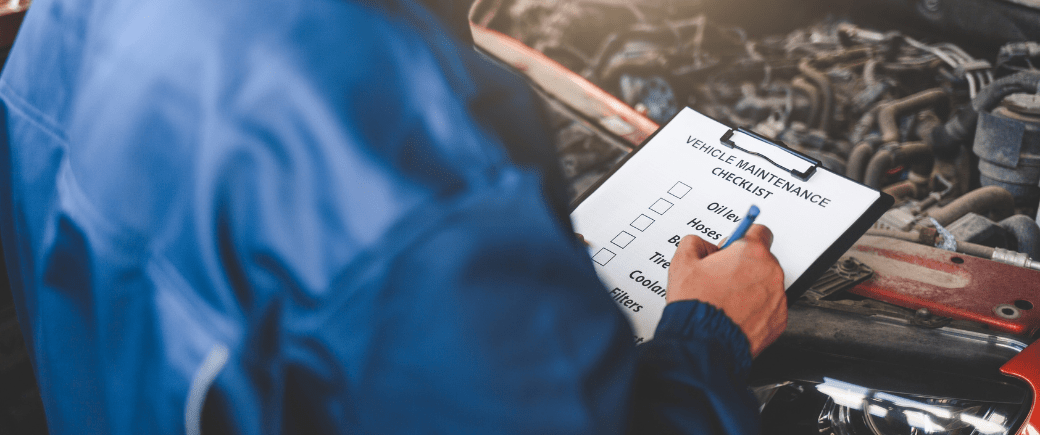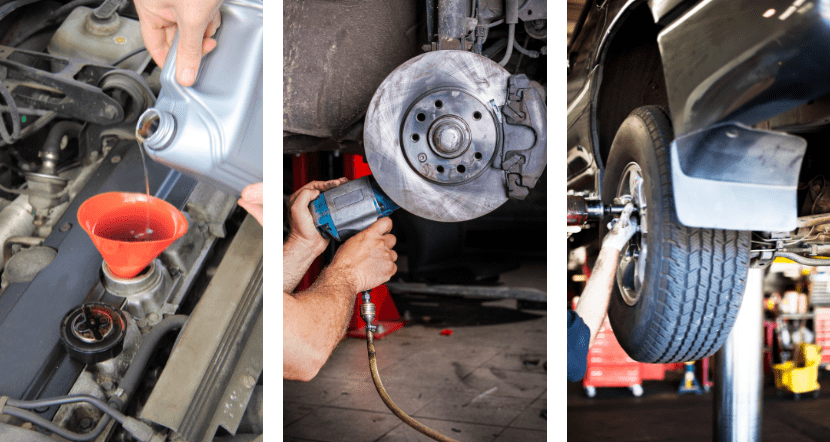WHAT IS A TYPICAL CAR MAINTENANCE SCHEDULE?

Regular maintenance of your car is important to improve its performance, safety, lifespan, and value. It includes oil and filter changes, fluid inspection and top-ups, air and fuel filter replacement, tire rotation, and brake inspection. It also is an opportunity to check for other issues that could become problems in the future. Some issues, such as problems with the brake system and tires, need to be inspected right away to ensure the safety of the driver and others on the road.
Scheduling of car maintenance is usually based on mileage or time intervals. In general, you should take your car in for an oil change following your vehicle’s recommended maintenance schedule. If you suspect there is an issue, have it checked out sooner. Check your manual for maintenance recommendations for your vehicle brand.
In this guide, we will cover everything you need to know about car maintenance, the important milestones for scheduled maintenance, and the warning signs you need to look out for. Let’s begin with understanding some of the most important car repairs and maintenance.
WHAT ARE THE MOST IMPORTANT CAR REPAIRS AND MAINTENANCE?
The most important areas to keep well maintained on your car are the oil, brake pads, air filters, and tires.
OIL CHANGE
Oil is what keeps your engine running smoothly. The heat from the engine breaks down the oil. If it becomes too thin, it won’t lubricate the engine as well and can lead to faster wear and tear. Depending on your vehicle and the type of oil used, you should have scheduled oil changes following your vehicle’s recommended intervals. Engines that use conventional motor oil can be on a 3-month/3,000-mile interval. Those using synthetic varieties might have up to 10,000 miles between oil changes.
BRAKE PADS
Brake pads have no set schedule for when they need to be changed. Almost all brake pads come with a wear indicator that will make contact with a tab. When you hear a slight screeching or scraping sound, it’s time to need to get your brakes checked.
AIR FILTERS
Clogged air filters can reduce your gas mileage, and horsepower, and cause your engine to stall. As your air filter gets clogged with dirt and dust, there is less airflow around your engine.
TIRES
Tires have built-in indicators to show their wear and tear. The tiny ridges should be 1/16 of an inch high. If you run your hands over your tire and notice them to be smooth, uneven, or have waves, it’s time to invest in a new pair of tires.
OTHERS
Various fluids, bearings, engine components, and electronics all require maintenance as well. Be mindful of your driving habits, the season, and your owner’s manual for a full vehicle maintenance schedule.

SIGNS YOUR CAR NEEDS MAINTENANCE DONE
Even the most well-maintained car will encounter problems that require unexpected service. Often, the vehicle will let you know before it stops operating that there’s an issue needing attention.
The “check engine” light or “service engine soon” indication on the dashboard aren’t the only clues that should prompt you to call a repair shop:
Braking: Brakes problems are serious safety issues. Investigate a “soft” brake pedal or any unusual sounds immediately.
Lacking acceleration: A change in performance can mean that it’s time for an engine tune-up.
Vibration: Have a mechanic diagnose the causes if you feel the car is vibrating while driving or braking.
Stalling or difficulty starting: When your vehicle stalls or you can’t get it started, it’s time to get it checked.
Fuel efficiency: Bad sensors or leaky fuel injectors might be the reason for changes in your gas mileage.
Shifting: Automatic transmissions are designed to shift gears smoothly. Hard shifts and lurching might indicate a transmission problem.
There are less obvious clues that something might be wrong with the car, and these signs can be intermittent or vague. Remember that you know how your car drives better than anyone does. If something seems different, it might be the start of a more significant problem.
Contact your FastLap service advisor and let them know what you feel and hear when the car begins acting up.
VEHICLE MAINTENANCE CHECKLIST
Keep up with a schedule of preventative maintenance to maximize the lifespan and performance of your vehicle. Use this list to be aware of what – and when – tasks should be done to help keep your car in proper working order.
Service intervals can vary from make and model, so be sure to follow your vehicle’s maintenance schedule.

SERVICE NEEDED
Check engine light: The warning light appears when the car’s control system discovers a problem. There is no reason to panic when you see this yellow warning light, but don’t delay a visit to the repair shop, and don’t reset it on your own without knowing why it came on in the first place. Our service technicians can help to determine the cause.
Headlights/taillights: Check for blown fuses if a light goes out. Replace the light if that isn’t the problem. Driving with burned-out lights is unsafe and can bring you a traffic ticket.
Tire pressure light: A car’s tire-pressure monitoring system will alert you when the air pressure in a tire drops below a certain amount. Low air pressure can bring unsafe driving conditions, so inflate your tires to proper levels as soon as you can.
MONTHLY CHECK-UP
Here’s everything that you need to inspect on a monthly basis.
Fog lights, turn signals, brake, and parking lights – It’s relatively easy to notice a headlight that isn’t working. Others aren’t as obvious, so walk around the car monthly to visually inspect the lights.
Oil and coolant levels – Check levels when the engine is cool at least once a month and always top off the levels before making a long trip.
Tire pressure and tread depth – Tires are essential to safe driving. Regularly inspect your tires and the spare for uneven wear, proper air pressure, and adequate tread depth. Use a penny to check the tread depth. If the top of Lincoln’s head is covered, there is still more than 2/32” of depth remaining, meaning there is still adequate tread left.
Windshield wiper fluid – Be sure the reservoir has an adequate supply of wiper fluid. It’s not possible to drive safely with an obstructed view, something that can result from a dirty windshield.
3-MONTH CHECK-UP
3-month check-ups are more extensive and usually entail a detailed inspection of the following:
Oil and filters: Engines that use conventional motor oil can be on a 3-month/3,000-mile interval. Those using synthetic varieties might have up to 10,000 miles between oil changes.
Battery and cables: Make sure the battery and cables have tight connections and are not corroded or leaking fluid.
Belts and hoses: The serpentine belt and other belts in the engine compartment shouldn’t look glazed, cracked, or frayed. Hoses shouldn’t leak or have cracks or bulges.
Power steering fluid: Check the power steering fluid level when the engine is warm and add more when needed.
Wiper blades: Driving with worn wiper blades is a safety hazard because of reduced visibility when it rains. Inspect the blades seasonally and replace them if they’re damaged or no longer clear the windshield.
6-MONTH CHECK-UP
6-month check-ups are crucially important to maintain the health of your vehicle’s tires, exhaust system, chassis, and outer body.
Rotate tires: Rotating tires helps extend their life by balancing the tread wear and can help prevent noise and vibration problems. Check the owner’s manual beforehand because some types of tires and wheels shouldn’t be rotated or have to be rotated in a very specific way.
Wax vehicle: Wash your car regularly and apply a wax coating at least twice a year to help protect your car’s finish from rust.
Exhaust system: Look for and repair any damage, especially if the muffler is making noise.
Battery performance check: Your car won’t start without a good battery. In the beginning when the battery is 3 years old, test it twice a year.
Chassis lubrication: Your owner’s manual will say if the chassis, steering, and suspension systems require periodic lubrication.

1-YEAR CHECK-UP
Some parts of your vehicle require inspection and replacement on an annual basis, such as the cabin air filters and coolant. Here’s everything that’s inspected and repaired during your car’s annual maintenance check-up.
Air filters: Cabin air filters help clean the air inside the car and should be replaced annually. However, engine air filters keep debris out of your engine and should be inspected when the oil is changed.
Brakes: Inspect the brake system, including the brake fluid, brake linings, rotors, and brake pads, to help ensure the proper operation of these critical components. The lifespan of brake pads largely depends on the driving style of the operator.
Inspect shocks and struts: Take your car to the shop if you notice a decrease in smoothness when driving. Shocks and struts are an essential part of the car’s steering system and should be inspected by a professional.
Coolant/antifreeze: Replace every year. Flush the coolant and the entire cooling system after 60,000 miles.
2-YEAR CHECK-UP
To keep your car’s ignition, transmission, and fuel systems in perfect shape, they should be inspected by professional technicians once every two years. When you bring your car for 2-year maintenance check up, here’s what we inspect and replace:
Ignition system: Good quality spark plugs, plug wires, coils, and other electrical components can last up to 100,000 miles. Even so, it’s a good idea to have spark plugs checked starting at 30,000 miles. Rough running or hard starting can be a sign that they’re beginning to fail.
Transmission fluid: Check transmission fluid levels regularly and add more when needed. You can expect to change transmission fluid between 30,000 miles and 60,000 miles in a manual transmission vehicle and between 30,000 miles and 100,000 miles in an automatic transmission one.
Fuel filter: Manufacturer guidelines for fuel filter replacement vary. Some suggest replacement at 30,000 miles.
LONG-TERM CHECK-UP
To increase the lifespan of your vehicle, you need a long-term maintenance plan to repair and replace the parts that go through regular wear and tear. The long-term check-up of your car must cover the following:
Transfer case fluid: The transfer case shifts power from the transmission to the axles in a 4-wheel-drive or all-wheel-drive vehicle. Have a professional check transfer case fluid according to the car manufacturer’s recommendations.
Front and rear differential: Differentials are devices that split the torque from the engine and send power to the tires to propel the car. The differentials require lubrication, and a professional should check them according to manufacturer recommendations.
Change tires: Tires can last from six years to 10 years. Check often for adequate tread depth greater than 2/32 of an inch.
Battery: Test the battery beginning at three years. The need for replacement is normally after five years.
Timing belt: Replace following the owner’s manual guidance, typically between 60,000 miles and 90,000 miles. Not all vehicles have timing belts. Yours might have a timing chain, which often needs no periodic maintenance (or replacement) unless there’s an issue.
We hope this article helped you understand the importance of regular maintenance and the warning signs to look out for. However, these milestones for car maintenance are general guidelines and not an exhaustive list. We advise you to carefully follow your car manufacturer’s recommendations on scheduled vehicle service. And the most important thing is to find auto repair professionals who can help you with your car’s needs and provide you with the level of maintenance that your car deserves.
At FastLap, we have a team of trained technicians who are dedicated to improving the performance of your vehicles. Get in touch with us to discuss your car’s scheduled maintenance or book an appointment now.
